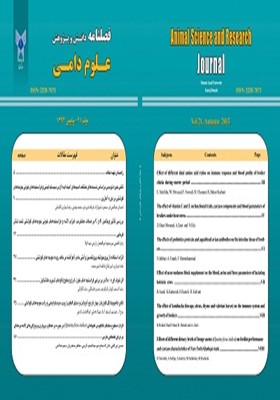About the journal
Recent Articles
Most Viewed Articles
-
Open Access Article
1 - Effect of Nano-selenium particles and sodium selenite on performance, carcass characteristics and antioxidant enzymes of quails under heat stress
Ebrahim Talebi * ، Reyhane GhazanfarpoorIssue 1 , Vol. 1400 , Autumn 2021 -
Open Access Article
2 - Determining the optimum metabolizable energy of diets of ROSS 308 broiler chicks
Mahan Kazemi ، Nima Eila *Issue 1 , Vol. 1400 , Autumn 2021 -
Open Access Article
3 - The study of MHC-DRB3 gene Exon region polymorphisms by PCR-RFLP in some breeds of horses in Iran
Mohammad Tavakoli ، Alireza Noshary * ، Behzad HemmatiIssue 1 , Vol. 1400 , Autumn 2021 -
Open Access Article
4 - The effect of mixture of Thyme and Garlic powder on quality of laying hen production and some blood metabolites
Mohammad Heydari ، Nima Eila * ، Majid AfsharIssue 1 , Vol. 1400 , Autumn 2021 -
Open Access Article
5 - Effect of corn and wheat glutens on performance and carcass traits of broilers
Ali Saki ، Abolfazl Zarei * ، Nima EilaIssue 1 , Vol. 6 , Winter 2023 -
Open Access Article
6 - Determination of metabolizable energy and daily requirement of forage dry matter in maintenance condition for grazing sheep in siah palas rangeland (Study: Lar National Park)
Hadi Mansouri khah * ، Mohammad Chamani ، Naser Karimi ، Ghobad Asgari Jafarabadi ، Kazem KarimiIssue 1 , Vol. 6 , Winter 2023 -
Open Access Article
7 - Growth Performance and Duodenum Morphology of Arian Male Broilers Fed Different Probiotics in Starter Phase
Rohollah Dozuri ، Hamidreza Aliakbarpur * ، Hadi HaghbinIssue 1 , Vol. 1400 , Autumn 2021 -
Open Access Article
8 - Investigation on using spent wheat straw compost of Agaricus bisporus mushroom residue in the diet of fattening calves
Alireza Talebian Masoudi *Issue 1 , Vol. 1400 , Autumn 2021 -
Open Access Article
9 - The effect of vitamin C and E on functional traits, carcass components and blood parameters of broilers under heat stress
Zahra Ghazi Mirsaeed ، Abolfazl Zarei * ، Nima EilaIssue 3 , Vol. 94 , Summer 2018 -
Open Access Article
10 - A Survey on Cost Structure of Poultry Broiler Farms “Case Study of Sanandaj and Kamyaran Cities, Iran”
Niv Nozari * ، Hamed Ghaderzadeh ، Kamal MirzaeeIssue 2 , Vol. 92 , Winter 2013


